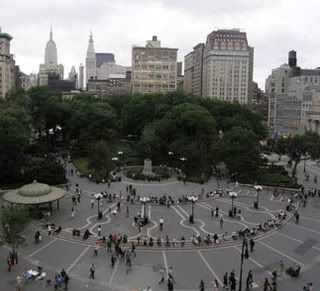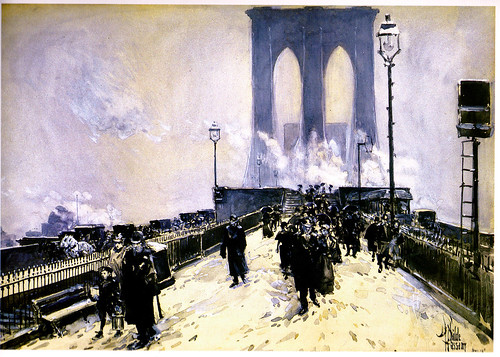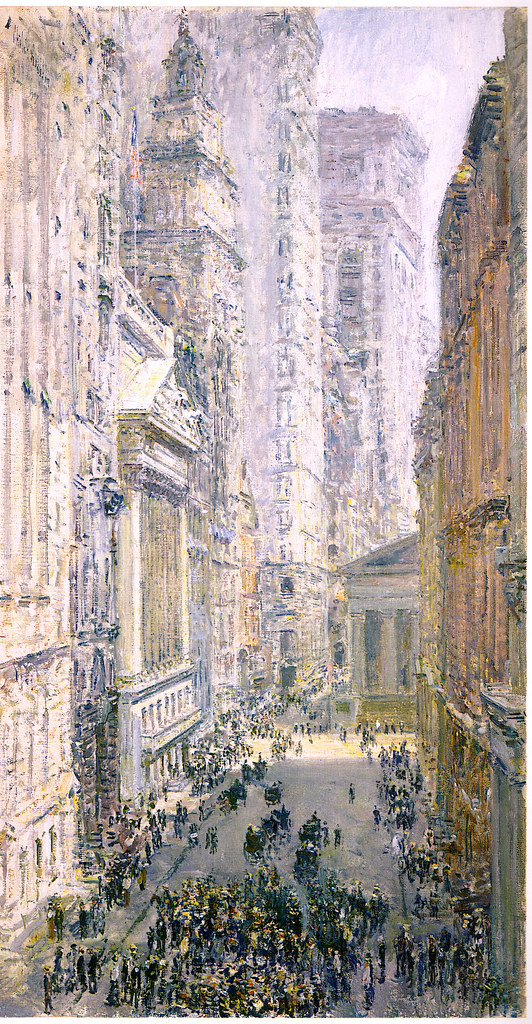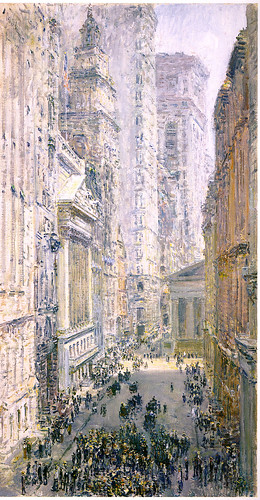Winter in Union Square
What I first noticed about the painting was the weather. I don’t have much to say about that, other than that I’m not looking forward to meteorological history repeating itself this year (I thank God every winter for global warming… evidently he answers the prayers of American evangelicals who think climate change is “cyclical”). The second thing I noticed, though, were the horse-drawn buggies. I have plenty to say about that, and none of it political (except the parentheticals).
To me, the notion of New York without awful public transportation is as foreign as the notion of cause without effect (like, say, carbon emissions without rising global temperatures). But once upon a time, Union Square had horse drawn buggies! Buildings, a nice big stone church, no skyscrapers just yet but still, signs of advanced civilization… and horse drawn buggies! Today, it is where I transfer to the Q to Brooklyn, or the 6 to the Honors dorms, or the L to 1st avenue (more scenic route to the Honors dorms; I believe it’s faster as well), or the 4 and 5 on those rare occasions when I have somewhere to go uptown that isn’t Hunter college. All of which are miserable, crowded, airless rides on tracks with mechanical signals from the 1920’s. But once upon a time, New Yorkers got around on horses and buggies. On the one hand, it makes me thankful for speedy mass transit. On the other hand, I wouldn’t mind some fresh (less polluted) air on my next trip uptown. For that, I envy Hassam.
(side note: his horse drawn buggies and trollies predate our mechanical train signals by only thirty years. And this painting was painted in 1890. I think Benjamin Harrison was president! Is it not time for an upgrade?!)
Union Square 2-Jacqueline Leon


The picture that I chose to replicate was the Union Square 2 one mainly because it was closest to the school and on one of my breaks, I decided to head there to take an easy snapshot. It was not that hard a picture to take considering that there is a mall standing right in front of the Union Square Park. It is quite evident that Hassam’s picture was created some time ago because there are less trees in his picture as well as less tall buildings and people surrounding the park. The view is a lot alike but not quite exactly the same. My picture is taken now in fall while Hassam’s was taken during spring since the color of the leaves are yellow. There were less people around in the park when he decided to paint his piece. Also the angle at which he made his painting at was different compared to my snapshot. He must have been at a location that was to the left of where I was because my picture is more centered and his is not. Union Square 2 was a good and somewhat easy choice of picture to try to replicate because of the position, which Hassam decided to paint. On the other side of the park, there was construction and the park would look unappealing in the picture that I would have taken. The Starbucks on the other side was also very crowded and I couldn’t seem to take a picture from there either because the sun was too strong and people were drinking coffee near the windows. Technology and modernization throughout the years makes the park a different environment. Hassam has made a nice painting that is ephemeral in the sense that it hard to exactly duplicate but getting to know the city a little better through art made it a fun experience.
Union Square 2
I chose to do Hassam’s “Union Square 2” as my recreation picture but unfortunately I found many obstacles in trying to take the picture. Obviously Hassam’s picture was taken sometime in the fall as much of the foliage has fallen or is pigmented yellow, on the other hand in part due to global warming, the trees in Union Square today are still in full bloom. Additionally it seems that Hassam was atop a building when he painted this picture owing to the fact that all on sees of the park is the upper left hand side (and he couldn’t have been suspended in the middle of the park while he painted this). I was able to get as high as the 6th floor in the Filenes department store in order to take this picture but I have a feeling that he was on the very top of the building as seen by the angle of the ground in relation to the road. Additionally the dense foliage made it hard for me to see the intersecting roads so I had to use Google Maps to verify that Broadway turns on to 16th street t the angle displayed in Hassam’s painting. As for the positioning of the picture, I used the tall buildings in the background as a point of reference since they were there in the Hassam painting as well. Overall, from looking at everyone else’s comparisons I feel that New York was a much more interesting place at the turn of the century. Although that may have been because Hassam was a good artist.
Hassam NYC Joel Kaplan
I chose Hassam’s Winter In Union Square (1892) because it relates in part to my group topic, symbolism and iconography. Hassam’s paintings depict a period of immense change and transition in NYC. Buildings began to rise and a skyline of unprecedented height began forming during the early 1900s. Prior to the use of steel in forming the backbone of our skyscrapers, stone was used in the tallest structures, which were always the gothic churches and religious buildings. In Winter in Union Square, the faint spire of Trinity church can be seen in the deep background through the clouds and haze of downtown Manhattan. To the right of the church is the Domestic Sewing Machine Company, which appears taller and broader, and dominates the view. The bright blue and red trolleys in the foreground (notice they are horse-drawn trolleys) form a trail across the canvas, not in any way oriented with regard to the spire, but only momentarily beneath it.
The meaning of this arrangement is fairly obvious: the power and influence of the church is waning and fading, its role in the lives of urbanites soon to disappear among the rising structures of commerce and modernity. Regarding the painterly technique used, I cannot note much except that Hassam’s brush strokes seem to work best when weather affects the image; snow and rain allow for the blurred definition that Hassam achieves in much of his painting.
P.S. - My Flip isn’t working right, I can’t seem to transfer video, so unfortunately I don’t have the comparison image.
Hassam’s New York-Broad Street


Above are pictures of modern day Broad Street.
Hassam’s Original Painting.
There are quite a few differences between my photo and Hassam’s painting. The most obvious being the angle and perspective differences. In Hassam’s painting, he was probably perched in a building so as to create the omniscient feeling of being able to watch the activities below. I was unable to do that so my photo is from the perspective of one the people on the street in the painting. It was also difficult to mimic the distance from which the original was made due to various lights and vans obstructing the view.Now the NYSE is pimped out with American flags, which now cover the columns, in commemoration of September 11th. But i was able to reconstruct the image of both the NYSE and Federal Hall as well as the skyline, although that has gotten a little taller in the past century. The whole area of Wall Street has an old world air because many of the original structures remain, however, in my photo all of the buildings, except the NYSE and Federal Hall, are newly constructed and more modern.
Mikaela Murph
This Thursday
We are meeting at the Metropolitan classroom space downstairs at 10:30. If you have a camera bring it along with your one-pass.
Heather’s Review of Jeff Koons on the Roof- Extra Credit Assignment
It was silly and ridiculous, but quite delightful. The exhibition was made up of three sculptures: a larger-than-life balloon dog, a heart wrapped up for the taking and an illegible mass of color depicting a cartoon character. Set against the backdrop of the New York skyline, these items take on an even more surreal quality than would be experienced inside of the museum, where whimsy and color are expected.
From a purely aesthetic point of view, the details of the wrinkled paper on the heart were impressive and appreciated, through the “Coloring Book” sculpture, nothing but a mass of color, seemed odd and out of place next to the other two definitive symbols.
On a deeper level, and connecting it to the concept of Symbolism, I’m not sure I got the deeper meaning behind the sculptures. The “Sacred Heart (Red/Gold)” was obviously about the commercialization of emotions and “love” in our society. And once I was informed of the identity of “Coloring Book” I was able to ascertain an odd message of hero worship and celebrity, even of a character of infantile fiction. Obviously, I’m still an amateur art critic, so I missed the hypersexual message behind the balloon dog I was supposed to catch. The exhibit really did point out how touch-and-go symbolism can be sometimes. People often discredit artistic symbolism because of the argument “How do we know that’s actually what the artist intended?” I take the opposite view. For example, I may have been able to understand a meaning for the balloon dog all my own if it weren’t for the fact that I was “supposed” to see a sexual concept. Symbols are about the story being told and I believe that story is a collaborative effort by both the artist and the viewer. Simply because my interpretation was not the original meaning doesn’t mean it isn’t still a valid way of viewing the piece- it’s simply how it relates to my unique point of view and experiences.
As for advanced critics, they all seemed to dislike the exhibition. They felt it was dwarfed by the outer elements and was generally kitschy, clichéd and silly.
I would recommend you see for yourself- at the very least it’s interesting to look at.
The Brooklyn Bridge by Jin Woo Chung

Above are two pictures of New York’s great tourist attraction, the Brooklyn Bridge. Considered an amazing feat of engineering during its times, the Bridge is depicted in Hassam’s painting not too long after its construction. Being an impressionist, Hassam depicts the Bridge as a huge, foreboding monolith in the back in the cold day as men, women and children make their way from it. The vanishing point is obvious as the linear perspectives centers on the bridge itself. The eerie smoke and hazy outlook gives the picture an ephemeral appearance.
In contrast to Hassam’s painting stands the good ol’ photo I took last week. Unlike Hassam’s, the Bridge here looks inviting and social, as people stand around it to talk or people just jog along it for some exercise. In the background can be seen the Brooklyn skyline, illustrating the modernity of the setting. The vanishing point is once again centered on the bridge and is the visual, realistic snapshot of the actual bridge.
Both these pictures showcase the Brooklyn Bridge, but Hassan’s makes his depiction of it quite cold and distant, while my photo of it shows it as a nice, inviting place for tourists around the world to gather and enjoy the site. Oh my! How New York has changed, hurry for gentrification and commercial tourism!!!
The Brooklyn Bridge - Alexander Schinis
Bridges — while New York City has many of them, the Brooklyn Bridge stands out from amongst them as an almost iconic symbol of the City. Above are seen two different pictures of the bridge, the first as it is depcited by artist Childe Hassam and the following being a picture of the actual modern day bridge. Both representations were produced from nearly the same viewpoint, and we can see that both bridges are nearly identical, with a few exceptions.
As seen in Hassam’s painting, the Bridge itself is more simple, yet more austere, than the modern bridge. It seems to loom in the background, wreathed in fog, appearing to be simple, powerful, and even cold. Hassam captured, too, the hustle and bustle of the bridge crossing folk, but as we can see, he gave them no faces and did not fill them with color; rather, we see the forms of people, somewhat indistinct, passing onward to their unknown destinations. The artist seems to be making a statement about the nature of the city that the bridge is located in.
Conversely, in the modern photograph, we see the bridge bathed in sunlight on a beautiful sunny day. There is foot traffic on the bridge, but the faces are clearly shown, and the people in the picture are wearing color as opposed to the black and gray of Hassam’s painting. The viewer can see some clear discrepancies between the two.
What can be inferred from this? To me, it seems clear: New York City has changed since Hassam’s time, from a rather grim, uninviting city to what many consider to be the very capitol of the world itself.
Broad Street Theresa Raniolo
I find this particular painting of Broad Street very interesting because of its specific location. Examining Broad Street the other day, I discovered that it runs north to south and then bends toward the East River. Hassam was situated at an elevated location right where Broad Street bends looking north toward Wall Street when he painted this. His location gave him a clear view of not only the street and masses of New Yorkers, but also of the Stock Exchange, the financial capitol of the world, and of Federal Hall, the first capitol of our nation. The direction of the crowd seems to be headed north toward Federal Hall, drawing our eye up the street to the historic site framed by the two rows of skyscrapers. Our eye is also generally drawn to the vanishing point of a painting; this painting’s vanishing point lies behind Federal Hall.
It was no accident that Hassam chose this particular setting to paint. It juxtaposes historical New York with modern New York, New York’s rich past, symbolized by Federal Hall and the wealth of ideals of the founding fathers, with its richer present, symbolized by Wall Street and physical wealth. There is certainly artistry in this painting since Hassam probably exercised artistic license when he painted the crowds, all moving in the same direction and concentrated at the bottom of his composition. The way he uses shadow and light also highlights the two buildings that are his focal points, and gives your eye a path to follow when looking at the painting.
Broad Street was closed for a rally when I took the picture on the left, so I was able to stand in the street before the bend; I was unable to get a picture from a higher point looking down on the street as Hassam painted from, but you can still see Federal Hall and the Stock Exhange on the left, draped in the American flag.











